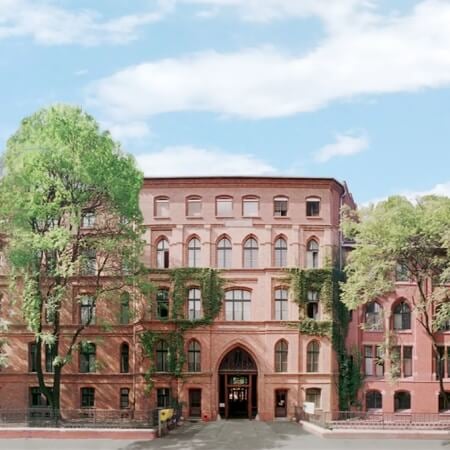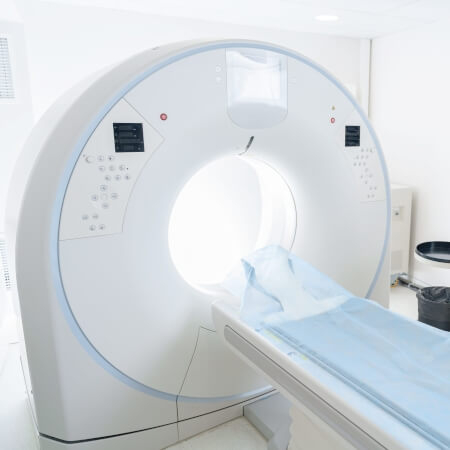Rezum Water Vapor Therapy for Benign Prostatic Hyperplasia (BPH) in Germany
Treatment prices are regulated by national law of the corresponding countries, but can also include additional hospital coefficients. In order to receive the individual cost calculation, please send us the request and medical records.

Department of Urology
The Department of Urology provides a full range of medical services to patients with diseases of the kidneys, bladder, ureters, and urethra. The department also provides qualified medical care to representatives of the stronger sex with pathologies of the prostate gland, testicles, and penis. The specialists of the department are focused on effective and at the same time sparing treatment with the use of the latest medical technologies. If a patient has indications for surgical treatment, laparoscopic or robotic surgeries using the state-of-the-art Da Vinci system are performed whenever possible. The department's team of urologists has unique competences in the treatment of benign prostatic hyperplasia: both standard treatment procedures (transurethral resection of the prostate) and innovative interventions (HoLEP, Rezum and others) are performed here. Of particular interest to the department's specialists is also the treatment of urolithiasis using extracorporeal shock wave lithotripsy (EWLT), ureterorenoscopy with laser lithotripsy, percutaneous nephrolitholapaxy, and robotic nephrolithotomy. It should be noted that the Department of Urology at the Alexianer St. Hedwig Hospital Berlin first opened its doors to patients in 1922 and for decades of work still confidently occupies a leading position among the top urological clinics in Germany, providing patients with excellent medical care.


Department of Urology
The Department of Urology offers advanced diagnostic and treatment methods for prostate cancer, bladder cancer, and benign prostatic hyperplasia. The key area of the department's specialization is prostate cancer treatment using irreversible electroporation (IRE) and photodynamic therapy (PDT). It is the only department in Europe where more than 1,500 irreversible electroporation procedures for prostate cancer have been successfully performed. This procedure is an excellent alternative to the classical treatment method for this type of oncology, a prostatectomy. The IRE technique demonstrates excellent success rates, while the risks of urinary incontinence are completely eliminated, and erectile dysfunction may potentially occur in only 3-5% of cases. It is impossible to achieve such outcomes with standard treatment approaches. The department has also gained unique experience in performing photodynamic therapy for prostate cancer and bladder cancer. Innovative methods such as immunotherapy and electrochemotherapy are widely used in the department to combat cancer. The treatment of benign prostatic hyperplasia with the GreenLight laser and the Rezum device complements the department's therapeutic offer. The department's doctors prefer an individual approach to treating each patient, taking a highly responsible approach to selecting the optimal treatment method.

Benign prostatic hyperplasia (BPH) is a condition that affects 40% of men in their 50s and 90% of men over the age of 90. Many of them require invasive procedures to reduce prostate volume. Rezum water vapor thermal therapy (WVTT) is one such procedure. It is performed on an outpatient basis to safely relieve the urinary tract symptoms of benign prostatic hyperplasia. You are welcome to use the Booking Health service to find out the cost of treatment, compare prices, and make an appointment for your treatment in Germany to receive quality healthcare abroad.
Content
- What is Rezum and how is the procedure performed for BPH?
- Advantages and disadvantages of water vapor therapy for BPH
- Treatment in Germany with the Rezum system
REZUM water vapor therapy is a minimally invasive procedure for treating benign prostatic hyperplasia (BPH), using steam to reduce prostate size and alleviate symptoms.
REZUM delivers targeted water vapor to the enlarged prostate, causing tissue shrinkage. This treatment process effectively reduces BPH symptoms with minimal risks and side effects.
Benefits include a minimally invasive procedure, a shorter treatment process, quicker patient recovery, and reduced risks and side effects compared to traditional surgeries.
REZUM shows a high effectiveness and success rate, with many patients experiencing significant improvement in BPH symptoms and long-lasting treatment results.
The cost of REZUM and overall treatment price vary. Costs in Germany typically cover the procedure, hospital stay, and follow-up care. Booking Health will provide you with the exact treatment price for your case.
What is Rezum and how is the procedure performed for BPH?
The Rezum water vapor therapy system was developed by NxThera (Maple Grove, Minnesota, USA) and approved by the FDA in 2015. As of 2018, it is also used in Europe.
The thermotherapy equipment consists of a steam generator and a transurethral delivery device, which is similar to a cystoscope (an endoscopic device for insertion into the urethra and bladder). The transurethral delivery device contains an optical system for visual monitoring of the procedure and a 1.3 mm diameter retractable needle. There are 12 water vapor holes at the tip of the needle.
The procedure does not require general anesthesia. Patients receive oral sedation and local anesthesia. Prostatic blockade and intravenous sedation may also be used.
During the procedure, a radiofrequency current is applied to an induction coil heater, which produces heat energy in the form of water vapor. The needle is inserted into the prostate tissue for 9 seconds, and the vapor delivery destroys the cells. The next injection is then given at a distance of about 1 cm. The total number of injections and the duration of the procedure depend on the volume of the prostate.
In any case, this procedure has a much shorter duration compared to other transurethral treatment methods. Water vapor therapy for benign prostatic hyperplasia takes an average of 8 minutes, while other treatments typically require 60 to 90 minutes.
The therapy is performed under continuous irrigation with saline solution, which not only provides an overview of the surgical field but also cools the urethra, thereby reducing the risk of complications.
A urethral catheter can be used after water vapor therapy. The average period of catheterization is 4 days.
Advantages and disadvantages of water vapor therapy for BPH
The Rezum water vapor therapy system causes necrosis of the targeted prostate tissue while leaving the surrounding tissue intact. This makes the method one of the safest treatments available for benign prostatic hyperplasia (BPH). Studies have found only short-term complications in the early period after the completion of the procedure, but 4 weeks or more after water vapor therapy for benign prostatic hyperplasia, patients do not have any complications.
In addition, the method is also one of the most effective minimally invasive procedures that allow for the destruction of prostate tissue in BPH of significant volume. The standard limits for Rezum are 120 ml, while most other procedures are recommended for prostate volumes up to 80 ml.
In fact, even 120 ml is not the limit. This is exactly the volume of the prostate for which water vapor treatment has already been proven effective. It is technically possible to perform thermotherapy for the prostate with a larger volume. The indications for Rezum water vapor therapy may be expanded in the future when studies are conducted to evaluate its effectiveness.
Below are listed the advantages of using water vapor therapy for the treatment of benign prostatic hyperplasia:
- The procedure can be performed even on elderly and debilitated patients
- The procedure allows the median lobe of the prostate gland to be treated
- The procedure does not cause erectile dysfunction in patients with preserved potency
- The procedure does not cause retrograde ejaculation
- The procedure has a lower risk of most complications compared to other transurethral treatments
- The procedure does not require general anesthesia
- The procedure is outpatient
- The procedure is quick
- The procedure has no risk of TUR syndrome (associated with long-term fluid irrigation) due to the short duration of the manipulation
The procedure is highly effective, successfully eliminating urinary symptoms in an average of 1 month. The average reduction in overall prostate volume 6 months after the procedure is 28.9%. The need for repeat procedures occurs in 3-5% of patients during 3 years of follow-up.
The disadvantages of water vapor therapy for the treatment of benign prostatic hyperplasia are as follows:
- The procedure is not suitable for patients with a history of recurrent urinary tract infections
- The procedure cannot be used for patients who have had other invasive manipulations on the prostate gland or after radiation therapy
- Since Rezum has been used in urology relatively recently, the long-term results of the procedure are still unknown
Another disadvantage is the lack of biomaterial (prostatic tissue) for a histological examination. During the procedure, prostatic tissue is destroyed rather than removed. When doctors perform TURP (surgical transurethral resection of the prostate), cancer cells are found in the samples at a frequency of 4.1-16.7%. Therefore, water vapor therapy is usually recommended for patients with low PSA levels (indicating a low risk of prostate cancer).
Treatment in Germany with the Rezum system
German hospitals have the Rezum system at their disposal and offer patients the service for the treatment of benign prostatic hyperplasia with water vapor. It is one of the most successful minimally invasive treatment technologies in urology and is characterized by health safety and high efficiency. It reduces prostate volumes and eliminates urinary symptoms with no hospital stay, no general anesthesia, and an average procedure time of 8 minutes.
If you want to have your treatment in Germany, you can find out the cost of treatment and compare prices in German hospitals on the Booking Health website. You are welcome to choose a suitable German hospital and make an appointment for your treatment in Germany for your preferred dates.
Please leave your request on our website to get advice from a Booking Health specialist. We will help you choose the most suitable German hospital and take care of the organization of your treatment in Germany. When you make your appointment through our service, the cost of treatment for you will be lower than if you contact a German hospital directly because of the absence of additional fees for foreign patients.
Authors:
The article was edited by medical experts, board certified doctors Dr. Nadezhda Ivanisova and Dr. Vadim Zhiliuk. For the treatment of the conditions referred to in the article, you must consult a doctor; the information in the article is not intended for self-medication!
Our editorial policy, which details our commitment to accuracy and transparency, is available here. Click this link to review our policies.
Sources:

